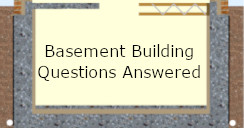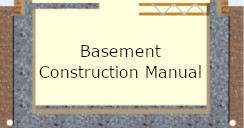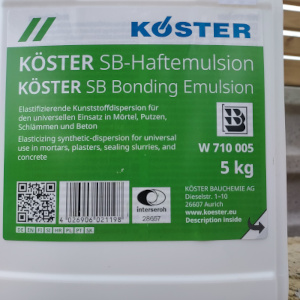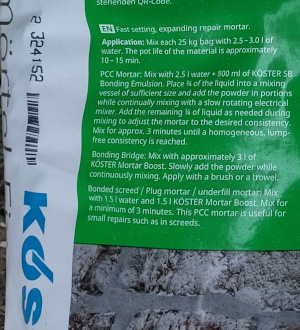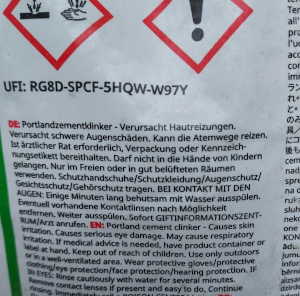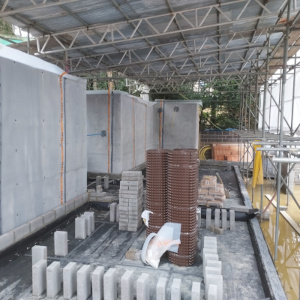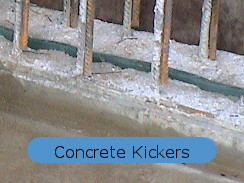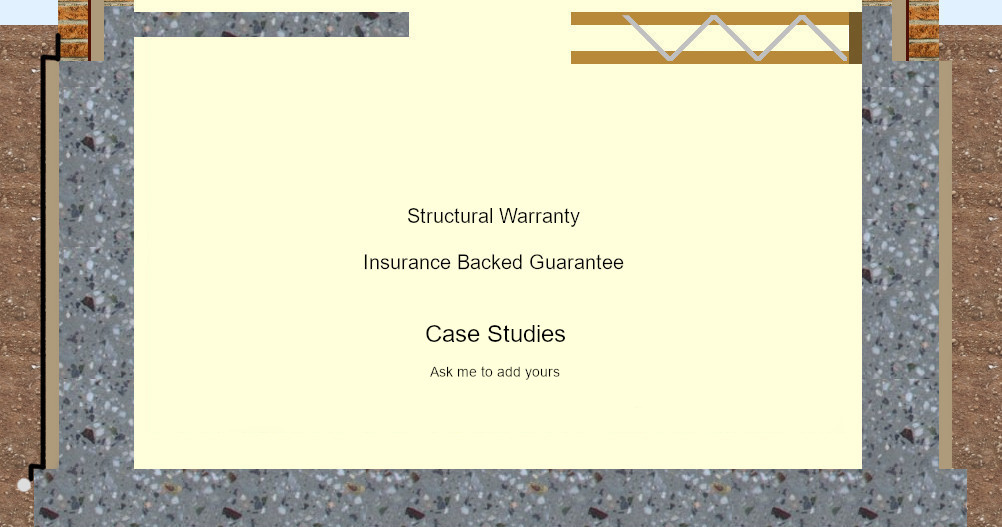
|
House Basement. Structural Warranty.Lenders still demand structural warranties, that don't include beneath ground waterproofing, from structural warranty providers who insist on an insurance backed guarantee for an internal drainage system that is not a waterproofing measure. And most building control bodies are just as bad. C2 of the building regulations, see it on the home page, makes it compulsory that walls, floors and roof of a building must be resistant to moisture. Turning a blind eye to leaks because there will be drainage membrane, a sump and a pump is a failure of compliance all building regulation bodies should identify and refuse to accept. Demanding all leaks are repaired instead. The only Approved Document, BS8102:2022, requires leaks to be fixed. It does not allow internal drainage as a waterproofing measure. If your lender, your insurer or your inspector force you to deviate from the Approved Document they are duty bound to explain and justify their choice. But they never do. Everyone is duty bound to comply with the Building regulations. Most haven't been since 2009. Last year I complained to Dame Judith Hackitt, the Secretary of State for DLUHC and the Housing Minister and months later I got a reply back from Richard, which you have probably seen already (on the home page). Essentially, this page is an expansion of a new complaint to DLUHC at the end of March 2024. As well as a follow up letter of complaint a few days later about another client also forced to do the wrong thing and structural warranty companies and internal drainage suppliers. All copied in to those at DLUHC. At the end of 2023, plots 1 and 2 were begun. 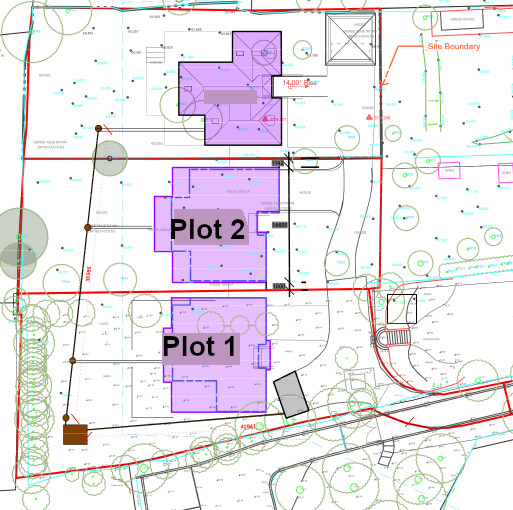
Plot 1 contracted a pair of particularly good contractors. Good men who will soon buy and do up their own properties, I'm sure. I expect that in a few years time they will only do their own work. They won't look for work ever again. Plot 2 employed a general builder they have used for years, a labourer and me to make sure the basement will never leak. They both approached Protek for a structural warranty. Plot 1 specified as see below. Plot 2 specified my usual, as you see below. I first of all created a guarantee I thought was very good that Protek could back with insurance. Then I had to sign a personal guarantee to indemnify them if they came after me for repairs. Only then did they put my case forward to an insurer. It turns out they offer insurance backed guarantees but they don't provide the insurance themselves. This, with a little editing to hide the location, is my letter to Dame Judith Hackitt. 24 March 2024. Dear Dame Judith, You said in an interview published April 22nd 2022 "One additional specific area of focus for us over the next year will be on the finance and insurance sectors," Hackitt adds. "They need to recognise the important role they have to play in creating the right culture by being able to differentiate between those who are doing the right thing and those who aren’t." This document is about an example happening now where nothing has changed. The insurer is compelling one client to use all the wrong products, whilst my client next door who does not need insurance is complying fully with the relevant British Standard without products but with supervision and good workmanship. The Standard is BS8102:2022 Protection of below ground structures against water ingress - Code of practice. On March 31st, 2022, this replaced BS8102:2009 Code of practice for protection of below ground structures against water from the ground. The 2009 edition was withdrawn, I believe, because allowing water into a basement to pump it out incentivised the workforce to leave more leaks and to leave worse leaks. Over the years between the two editions, the suppliers added more and more maintenance and more and more pumps to their quotations. I believe because during heavy rain enough mud came in to block pumps, the rain continued and basements flooded, mould developed, occupants suffered. The law was broken. The letter from Richard at DLUHC received last year, makes it absolutely clear that the law is there to protect occupants from harm. The 2009 edition caused the law to be broken. It had to be changed. No insurer has changed with it, as far as I can tell. Three types of insurance are involved.
NHBC is a structural warranty provider with one limited company and a different NHBC limited company is a building control body. NHBC Standards, available for all to read and follow online, was updated at the start of this year. Almost all reference to BS8102 was removed. The championing of a CSSW, someone qualified by the Property Care Association (PCA) as a waterproofing specialist (but the PCA remedies problems in existing buildings, not new-builds) continues. CSSWs specify the internal drainage systems, sumps and pumps their employer supplies. Many other warranty providers, architects and building regulation inspectors quote NHBC as the Gold Standard. But as the letter from DLUHC makes clear, any person or body departing from Approved Documents (BS8102:2022 is the only approved document for basement waterproofing) must justify their choice, which NHBC do not. So far, I have found it impossible to find an insurer willing to provide an IBG for complying with BS8102:2022. Note: I did have an insurance backed guarantee my basement would not leak for one basement I built about 2009, but QANW only want to insure fenestration these days. NHBC were the structural warranty provider and they happily accepted the IBG. Earlier, about 2006, another client was using NHBC. They wanted internal drainage but he didn't put it in. He moved in before he had finished everything and NHBC came back every year and made a list of things to do. For 5 years, that included install internal drainage. But they never saw a drip of water. In year 6 the list no longer included internal drainage. Architects are frightened that they are specifying a solution to a risk without insurance. I try to explain to them that they need to specify firstly complete compliance with BS8102:2022 and an inspection to confirm that the basement does not leak (following repairs if needed). Then, and not before, specifying another measure - totally unnecessary, obviously, that comes with an IBG to satisfy the structural warranty provider. But because that additional measure is highly likely to be internal drainage – despite there not being a single drip to pump out, the supplier able to provide the IBG might decline the business if their sump and pump are not already installed. Which was omitted out of necessity to improve the construction workmanship by removing the incentive to leave leaks. Several prospective clients have told me that their building regulations inspectors have insisted their basement waterproofing comes with an IBG. The inspectors claim that they can insist on raising standards at will. They seem to want to do so without understanding or complying with the requirement to justify a departure from the Approved Document. Case Study. I tried to sell myself to the owners of both plots 1 and 2 to ensure their basement structures were built to fully comply with BS8102:2022 and would not leak. Plot 2, who was going to have a structural warranty but decided not to, has used me and I am almost finished there. Plot 1, who needs to draw down mortgage funds and therefore needs a structural warranty said that because I rejected every measure that his structural warranty provider had approved, he dared not use me.
I supervised all the concreting to plot 2 and there are no apparent holes to leak. In all fairness, the workmanship on plot 1 has all been much better than the average one reads about in the trade press and reports by Dame Judith Hackitt. The workmanship complies with the building regulation C2 because their workmanship is very good. Not because of the expensive products. But the fact remains that the insurers, aiming to satisfy the lenders, have insisted the client pays a huge amount of money in comparison to waterproof concrete for a series of measures not approved by the Approved Document that in most cases elsewhere would have failed. Additional peculiarity. Beneath ground waterproofing is excluded from the cover by all structural warranty providers, as far as I can tell. Yet, strangely, they have powerfully held views that are wrong, and they require the IBG to re-insure what they don't insure themselves. One structural warranty provider, Protek, has just agreed that where they do not provide cover themselves, they do not require a product with an IBG. The owner of plot 1 is also using Protek. He doesn't yet know that they have changed their tune and they don't need the IBG he will get because he spent several tens of thousands of pounds on measures that don’t comply, because getting his mortgage funds is so important. I don’t think I have the heart to be the one to tell him. Yours Plot 1 Failure 1. The retaining walls all have flat tops that finish below what will be outside ground level. Water will be able to get over the top under mortar. 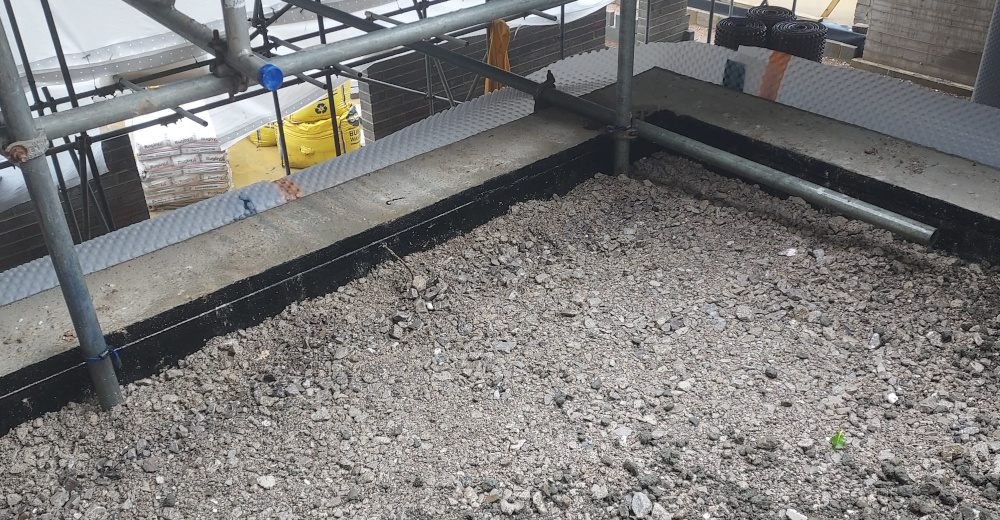
Failure two. The walls have been painted on the outside, as you can see above. The stone will have damaged the paint in places when it was poured in and it will damage it further when it is compacted down before the next material goes on top. The paint will have been damaged somewhere by the scaffold poles and there will be plenty of other things yet to come that will be dropped here before they find their way inside. The paint will never be repaired. The products making up the 3 coats mentioned in Plot 1 Failure 3 above are only SBR and cement with some extra alkali to make the cement start to set a couple of hours sooner. Nothing special. But all the way from Germany? Perhaps Germany means they can charge silly prices.
They sprayed the surface with pure SBR first. Then literally just painted the mixture on. 
Plot 1 Failure 4. Internal drainage membrane. Dimpled internal drainage membrane. Not a waterproofing measure and in most cases it being marked on the drawing and a sump for a pump incentivise the preceding contractors to leave leaks. 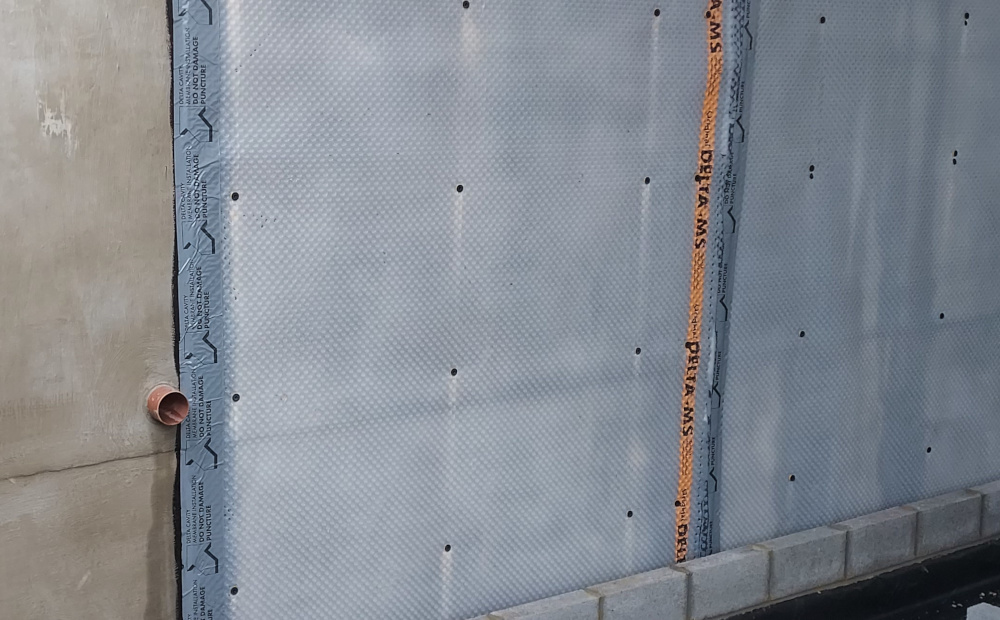
Failure 5. Sticky back membrane will often not stick because the atmosphere is too humid. in addition, it doesn't stick where difficult geometric shapes don't allow it to fold neatly. See the gaps here. Many trades would tear it as well, loading blocks out on it. 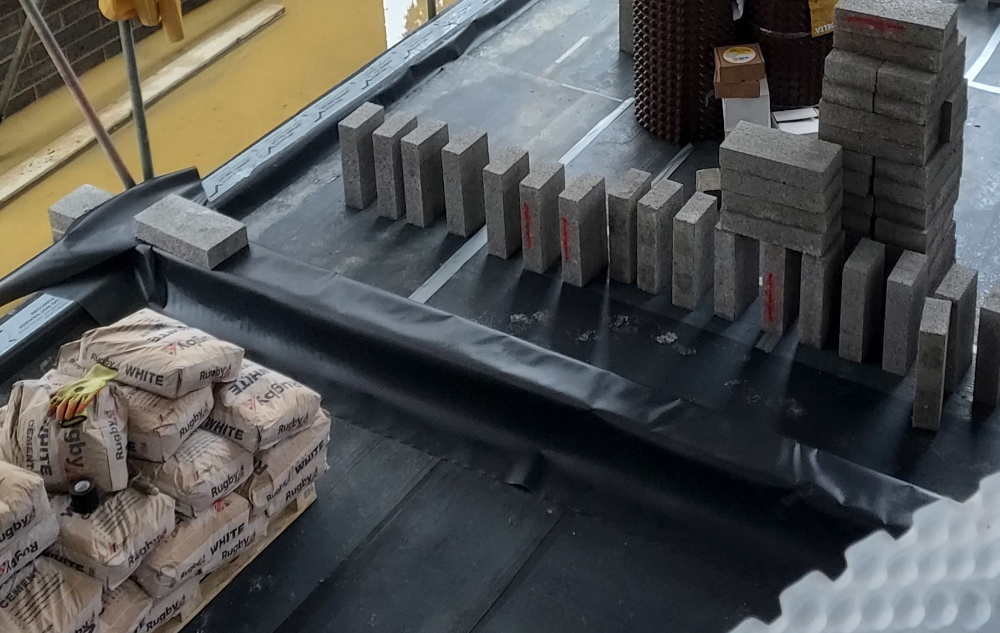
Just before I sent that first letter, I emailed someone else who had been keen on my methods but gone quiet. I wondered if he had built without me. He responded 4 days later. In terms of the basement we've eventually decided to go down the route of the so-called 'industry standard' approach, with big name admix, internal drainage membrane, and guarantees to keep the structural warranty providers happy. After everything I've learnt through your excellent website and advice it does feel like a bit of a defeat, and hopefully it won't come back to bite us - I'll let you know when it's finished. In any case thank you for all your help so far, and good luck with your crusade. I hope one day to work on a project where we can fully adopt your common sense approach! I sent another letter, 25 March 2024, to Dame Judith Hackitt and DLUHC with the quote above. It is months since I bothered NHBC and MD Insurance Services. MD are behind Premier Guarantee and LABC Warranty. Primarily warranty providers. Letters to NHBC and MDI, with copies and covering letters to DLUHC and Dame Judith Hackitt all posted 2 April 2024. The texts to the insurers are almost identical. Here is the text to NHBC. 2 April 20124. I have written to you several times over the past year or so, imploring your organisation to look inwards at why and how it fails your clients when it comes to basement waterproofing. I wrote to DLUHC and Dame Judith Hackitt almost a year ago. I got a reply, enclosed, last Autumn. It is very informative. I usually work alone. But I just worked next to another basement being built at the same time with an internal drainage system. Comparing my work and their work to the letter from DLUHC, I can see where NHBC breaks the law (and fails its clients and fails with Building Regulation compliance). Today I am informing you that I have written to the Secretary of State and others at DLUHC explaining how your organisation has routinely broken the law for at least the last 14 years, probably at every opportunity. I copied my letter to Dame Judith Hackitt in order that together they might deal with your organisation appropriately. Your organisation recently updated NHBC Standards for 2024. But your treatment of basement waterproofing is quite different to the letter I got from DLUHC. It is NHBC that is wrong. The DLUHC letter says 1. The Building Regulations set standards for the design and construction of building work. 2. Approved Documents are statutory guidance that set out what, for common building situations, would normally be accepted as reasonable provision for compliance. 3. if the guidance in the Approved Guidance has not been followed the person carrying out the building works must demonstrate that the Building Regulations requirements have been met by some other acceptable means. 4. regulation C2 states: "Resistance to Moisture. The walls, floors and roofs of the building shall adequately protect the building and people who use the building from harmful effects". Clearly, regulation C2 requires that the walls, floors and roof are resistant to moisture. The Building Regulation C2 says don't let the water in. The Approved Document says fix leaks. Don’t let the water in. The NHBC current guidance is that a CSSW will cover over the leaks letting the water in. Nowhere does NHBC demonstrate that the Building Regulations requirements have been met by some other acceptable means. In fact, you force architects, contractors, and clients not to comply with the Building Regulation C2 which, in turn, means that you sign off basements on Building Regulations that do not comply. Which is where you break the law, probably. Not once. Always. What does NHBC need to change, to allow its clients to comply with Building Regulation C2? It is actually remarkably simple.
NHBC is good at fine words. Just not good at making sure they are complied with.
Nowhere does NHBC guidance say find and fix leaks. If no one ever checks, contractors will leave more and more leaks. Bigger, worse and more as their confidence that no one cares grows. Because NHBC insist that a CSSW's internal drainage team are the first people to see the leaks after the basement has been backfilled, and they cover them over. I have a web page about leaks left by contractors here. Lots of photos. Easy to understand. www.basementexpert.co.uk/basement contractors.htm When I built a basement with an NHBC structural warranty about 2010, I was allowed to guarantee that the basement structure would not leak. I found QANW to provide the insurance backed guarantee and they specified that the basement had to be left untouched inside until the roof was on, the windows in, the basement pumped free of rain that collected, cleaned and dried. And only after a period of heavy rain did their Mike Billington inspect for leaks. He didn't find any. The IBG was issued. I was paid. I heard nothing during the 6 years I was responsible for fixing leaks. That client had complied with Building regulation C2. Perhaps the only NHBC client with a basement to do so for 15 or 20 years. It is ironic to me, that NHBC get all the problems covered over, perhaps negligently rather than deliberately, leading to the law being broken if someone later gets ill from mould, whilst excluding all basement waterproofing issues and compliance with Chapter 5.4 from its cover. And never realised. The IBG for internal drainage is for labour and materials only. There is no cover for flood damage or damages for ill-health. The CSSW insisted upon by NHBC liaises with the architect and the drawings include a sump and pump beneath the basement structural floor. The sump and pump inform the workforce at the very start that they can leave leaks. The NHBC experience for contractors is that they get away with poor workmanship, meaning more leaks and worse leaks as time goes by. Please also find enclosed a copy of my letter sent to Maclennan waterproofing. Yours faithfully, That brings us to the last letter copied to all at DLUHC, NHBC and MDI. As well as Newton, Delta, Assent BC and ABC+W. The letter to Maclennan waterproofing. I have written to you a couple of times before. My knowledge and understanding slowly grow. My letters to Dame Judith Hackitt and members of DLUHC got a response late last year. Please find a copy attached. I realise now that it is your company and your peer companies most guilty of not complying with Building regulation C2 nor complying with BS8102:2022.
NHBC, Premier Guarantee and LABC Warranty standards manuals all trumpet the advice from a CSSW. But you know full well that CSSWs work for you and the other suppliers. NHBC Standards include this: From the introduction to chapter 5.4. "This chapter includes guidance for walls, floors and foundations below, or near to, ground level that are intended to prevent the passage of water from the ground (including from sources such as run-off, burst pipes etc) entering the building near to or below ground level." The words I have turned red would comply with Building Regulation C2. More good words at 5.4.6 "Waterproofing systems should be designed to resist the passage of water and moisture to internal surfaces." But your company, and others like yours, accept the business to comply with NHBC Standards with no intention of complying. You like the culture, to quote MD Insurance technical guidance: "defects may occur as a result of poor workmanship". You keep quiet and break the law (Building Act 1984) because it means more business. You will know, I am sure, that on one of my web pages I have your quotation 28499 that I go through fairly carefully for my readers. I point out that you sneak internal drainage into the quotation as the major asset after two defences that comply with BS8102"2022, the external drainage and some extra cement rubbed into the structural concrete walls as a paste to make them a bit more water resistant. But as you very well know (one of your web pages says that 4 to 6 times a month you visit leaking basements let down by other suppliers) Building Regulation C2 and BS8102:2022 want leaks to be fixed. But that quotation says nothing about fixing leaking kickers, fixing voids above the kickers where dirt got washed out of the joint, fixing honeycombing at the bottom of the wall pour, fixing tie bar holes or fixing cracks. Nor your design specialist preventing another Approved Document requirement - the waterproofing should be continuous throughout the structure from its base to 150mm above outside ground level or DPC. Your CSSW does not prevent a flat top to a retaining wall below outside ground level which, as the waterproofing specialist on the design team, they should. YOU PREVENT BUILDING REGULATION C2 BEING COMPLIED WITH IN NEW BUILD DOMESTIC BASEMENTS. YOU KNOW THIS. YOU MAKE ARCHITECTS BREAK THE LAW. Yours Just a note about inspecting for leaks. As soon as a new basement, buried on all 4 sides, is complete. It becomes a swimming pool. I have gone by now, my work complete. But as the house above gets constructed, the bricklayers slop some mortar, the chippies drop small offcuts nails and screws, other trades drop packaging, the electrician peels back and drops the ends of cables everything gets swept or washed into the basement. Because until there is a roof the rain has nowhere else to go. The basement cannot be inspected for leaks when I finish my work. There is already water all over the floor and it is only going to get deeper. The rain will fall on the insides of the new walls. It is impossible to identify a small leak unless there is a hole. 
The project needs to wait until the roof is on, the windows are in, the basement pumped out, cleaned and dried. Then an inspection following a period of heavy rain. Before anything is allowed to be fitted to or cover the inside of the basement structure. At present, the first people in the basement after it filled with rain and probably before the roof is on are the internal drainage installation team. It is absolutely in their interests to hide all the leaks without trying to stop any of them to secure their work going forward. They don't want developers to learn their product cost is avoidable. This is another view of plot 1, above. The internal drainage has gone in and covered everything over long before the structure is weathertight. 
Before the structure could be checked to find out if it leaks or to fix leaks. An extra sentence or two in the letter to MD Insurance quoted a passage from their manual. Waterproofing Design Specialists are to consider the probability that systems may be inadequately installed and defects may occur as a result of poor workmanship, or that defects may be present in the supplied materials. Designing on the assumption that a system will not be totally perfect or free of defects, necessitates that consideration is given to the feasibility of repairing those defects at construction stage. A remedial repair strategy should be included within a design. The last two sentences say. repairing those defects at construction stage A remedial repair strategy should be included within a design. When you look at the typical photos above, this is obviously complete nonsense. Not of the real world. Unless it is forbidden to cover the inside of the basement structure with anything before it has passed inspection following repairs. The waterproofing design specialists, usually, are the CSSWs employed by the internal drainage system suppliers. When did they ever comply with the MD Insurance requirements quoted above? Probably never. They work in sales, not the compliance department.
|
